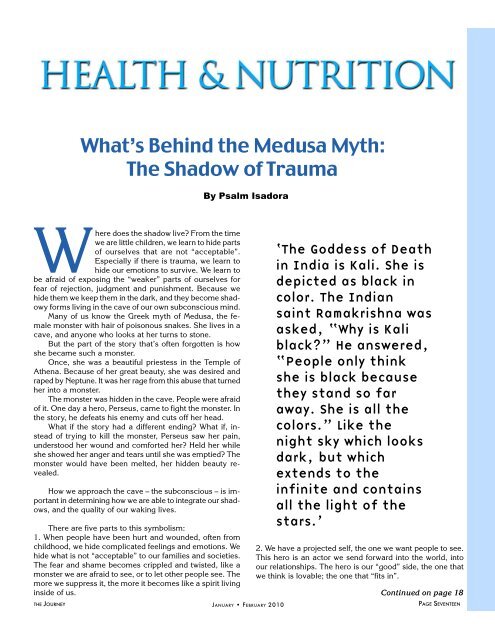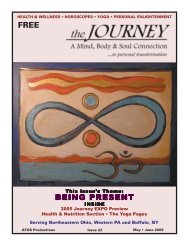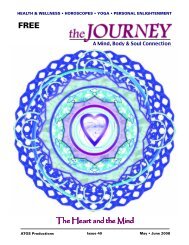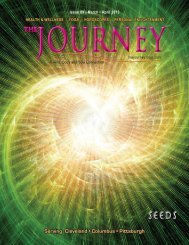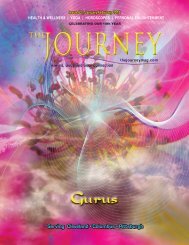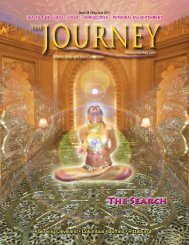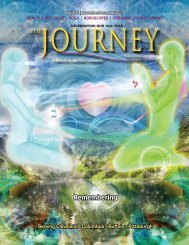January-February 2010 - The Journey Magazine
January-February 2010 - The Journey Magazine
January-February 2010 - The Journey Magazine
Create successful ePaper yourself
Turn your PDF publications into a flip-book with our unique Google optimized e-Paper software.
What’s Behind the Medusa Myth:<br />
<strong>The</strong> Shadow of Trauma<br />
By Psalm Isadora<br />
Where does the shadow live? From the time<br />
we are little children, we learn to hide parts<br />
of ourselves that are not “acceptable”.<br />
Especially if there is trauma, we learn to<br />
hide our emotions to survive. We learn to<br />
be afraid of exposing the “weaker” parts of ourselves for<br />
fear of rejection, judgment and punishment. Because we<br />
hide them we keep them in the dark, and they become shadowy<br />
forms living in the cave of our own subconscious mind.<br />
Many of us know the Greek myth of Medusa, the female<br />
monster with hair of poisonous snakes. She lives in a<br />
cave, and anyone who looks at her turns to stone.<br />
But the part of the story that’s often forgotten is how<br />
she became such a monster.<br />
Once, she was a beautiful priestess in the Temple of<br />
Athena. Because of her great beauty, she was desired and<br />
raped by Neptune. It was her rage from this abuse that turned<br />
her into a monster.<br />
<strong>The</strong> monster was hidden in the cave. People were afraid<br />
of it. One day a hero, Perseus, came to fight the monster. In<br />
the story, he defeats his enemy and cuts off her head.<br />
What if the story had a different ending? What if, instead<br />
of trying to kill the monster, Perseus saw her pain,<br />
understood her wound and comforted her? Held her while<br />
she showed her anger and tears until she was emptied? <strong>The</strong><br />
monster would have been melted, her hidden beauty revealed.<br />
How we approach the cave – the subconscious – is important<br />
in determining how we are able to integrate our shadows,<br />
and the quality of our waking lives.<br />
<strong>The</strong>re are five parts to this symbolism:<br />
1. When people have been hurt and wounded, often from<br />
childhood, we hide complicated feelings and emotions. We<br />
hide what is not “acceptable” to our families and societies.<br />
<strong>The</strong> fear and shame becomes crippled and twisted, like a<br />
monster we are afraid to see, or to let other people see. <strong>The</strong><br />
more we suppress it, the more it becomes like a spirit living<br />
inside of us.<br />
THE JOURNEY<br />
JANUARY • FEBRUARY <strong>2010</strong><br />
‘<strong>The</strong> Goddess of Death<br />
in India is Kali. She is<br />
depicted as black in<br />
color. <strong>The</strong> Indian<br />
saint Ramakrishna was<br />
asked, “Why is Kali<br />
black?” He answered,<br />
“People only think<br />
she is black because<br />
they stand so far<br />
away. She is all the<br />
colors.” Like the<br />
night sky which looks<br />
dark, but which<br />
extends to the<br />
infinite and contains<br />
all the light of the<br />
stars.’<br />
2. We have a projected self, the one we want people to see.<br />
This hero is an actor we send forward into the world, into<br />
our relationships. <strong>The</strong> hero is our “good” side, the one that<br />
we think is lovable; the one that “fits in”.<br />
Continued on page 18<br />
PAGE SEVENTEEN


